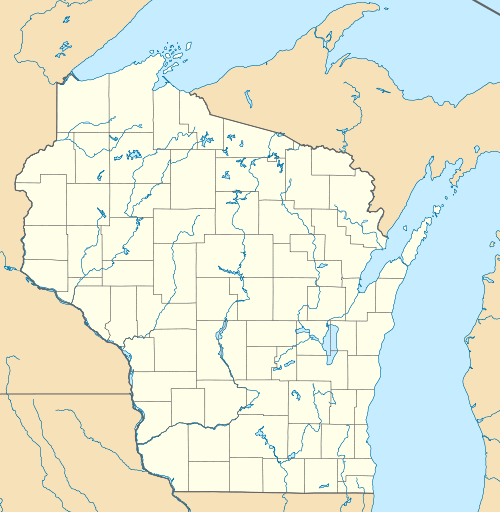McCoy Farmhouse (Fitchburg, Wisconsin)
|
McCoy Farmhouse | |
|
| |
  | |
| Location | 2925 Syene Rd., Fitchburg, Wisconsin |
|---|---|
| Coordinates | 43°0′51″N 89°23′49″W / 43.01417°N 89.39694°WCoordinates: 43°0′51″N 89°23′49″W / 43.01417°N 89.39694°W |
| Built | 1861 |
| Architectural style | Italianate |
| NRHP Reference # | 80000124[1] |
| Added to NRHP | May 29, 1980 |
The McCoy Farmhouse is a historic house located at 2925 Syene Road in Fitchburg, Wisconsin. The Italianate farmhouse was built in 1861 on an early Wisconsin tobacco house. Microbiologist Elizabeth McCoy lived in the house from 1949 until 1978. The house was added to the National Register of Historic Places in 1980.[2]
History
The tobacco farm on which the house stands was established after the crop was introduced to the area in 1853.[3] Farmers Ralph Pomeroy and Jacob R. Hiestand, both migrants from Ohio, rented the land from Henry Yager. During the American Civil War, the farm experienced a boom when tobacco from what had become the Confederate States of America became unavailable. Benjamin Brown purchased the farm from Yager in 1861 and built the farmhouse in the same year. As Brown's land was already prepared for tobacco farming, his farm was more successful than other area farms, and its value increased fivefold by his death in 1874. By this time, Dane County led the state in tobacco production, a status it held through 1911 when the farm ceased its tobacco production.[4]
In 1949, University of Wisconsin–Madison microbiologist Elizabeth McCoy moved into the house.[5] McCoy, a full professor at the university, was one of the first prominent female microbiologists. McCoy's work included bacterial research, studies of the microbiology of water bodies, and penicillin research which led to the discovery of the first commonly-used strain of the drug.[6] McCoy died in 1978 and left her house to the Wisconsin Alumni Research Foundation with the intent that it be preserved.[4]
Architecture
The two-story Italianate house is built from cream-colored brick which Brown imported from Milwaukee. The front facade features a central entrance and tall windows with stone lintels. A long front porch originally extended along the facade; while it had been replaced by a smaller porch by the time of the house's National Register nomination, another long porch has since been constructed. The house's hip roof is surrounded by a bracketed cornice and topped by a small cupola. A two-story wing extends from the back of the house.[4]
References
- ↑ National Park Service (2010-07-09). "National Register Information System". National Register of Historic Places. National Park Service.
- ↑ "McCoy Farmhouse". Landmark Hunter.com. Retrieved 2012-02-06.
- ↑ "The McCoy Farmhouse (Historical Marker Erected 1998)". Wisconsin Historical Society. Retrieved 2012-02-06.
- 1 2 3 Shoptaugh, Terry L., and Whitney Gould. National Register of Historic Places Inventory - Nomination Form: McCoy Farmhouse. National Park Service. December 3, 1979. Accompanied by photos.
- ↑ "The McCoy Farmhouse". Historical Marker Database.org. Retrieved 2012-02-06.
- ↑ Batt, James R. (June 1978). "Elizabeth, remembered". Wisconsin Academy Review. 24 (3): 3–6. Retrieved October 22, 2014.